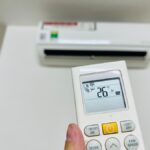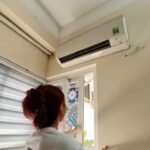Air conditioning is a popular topic of debate in many households during the summer months. Whether it’s finding the right temperature for maximum comfort or saving money on energy bills, people have strong opinions about the “right” way to use air conditioning.
Some common settings on a standard central air thermostat can also be confusing, such as the difference between the “On” and “Auto” settings. So, we consulted the experts to clarify the issue and confirm the best AC settings for optimal performance.
What’s the Difference Between “Auto” and “On” Settings on Your Air Conditioner?
First, the “Auto” and “On” settings on your unit or thermostat specifically refer to the fan inside the unit. “When the fan is set to ‘on,’ the fan will run continuously,” explains Stewart Parnacott, PhD, owner of Varsity Zone HVAC and director of Ready Wellness. “Whether the AC is cooling or not, the system pulls air through the vents in a continuous cycle. ‘Auto’ only runs the fan when the system is actively cooling, and the units shut off when the thermostat reaches the set temperature.”
“Think of ‘auto’ as a motion-sensor light that only turns on when needed,” adds Gerrit Jan Reinders, an HVAC expert and CEO of Reinders Corporation. “‘On’ is like leaving the light on all day.”
So, the key difference is that “on” allows the fan to run continuously, while “auto” only lets the fan run intermittently—but there’s more to consider to determine which mode is best for your home. While there’s one mode that experts agree is best for everyday use, there’s a time and place for both “auto” and “on,” so it’s important to understand the benefits and use cases for each.

When to Use “Auto” on Your Air Conditioner
All the air conditioning experts agree: “Auto” is the clear choice for everyday use. The main reason for this is that “auto” saves energy and, therefore, money.
As Reinders points out, “This setting is more energy-efficient because your fan isn’t running 24/7. Running the fan continuously can add $20 to $50 to your monthly energy bill.” (That’s quite a range!)
TJ Laury, president of Ben’s ProServ, concurs, adding that “auto” balances comfort and efficiency. “Running the fan continuously [while on] will significantly increase your energy bill and cause wear and tear on the fan motor and the entire system,” he says.
However, a potential downside of the “auto” setting is that the air can become slightly stagnant between cooling cycles, as the fan won’t be running. But Benjamin Uscilla, an HVAC technician and owner of Evergreen Heating and Cooling, has an easy fix for this. “Sometimes, the best trick is to simply turn on a ceiling fan and bump up the AC temperature a few degrees. You’ll still feel cool, and this will help save costs.”
When to Use “On” for Your Air Conditioner
While all the experts agree that “auto” is best for everyday use, they also concede that there are times when “on” is the better choice. In fact, Danny Pen, an HVAC expert and president of New Era Plumbing & HVAC, sums it up quite nicely: “‘Auto’ for everyday use and ‘on’ for special occasions.“
So, what are these special occasions?
One instance where you might need to use the “on” setting is if your home has varying hot and cold spots. If the bedroom is always warmer than the living room, for example, running the fan continuously will help mix the air and balance out that temperature difference. A constant airflow can help create a more even balance between rooms that never seem to maintain the right temperature.
The “on” setting can also be a good precaution for indoor humidity. It’s a good option if you need to reduce humidity buildup in the basement or stuffy areas outside of the cooling cycle. However, this isn’t a reliable solution in all cases. If your climate is humid, the “on” setting could actually make your home feel a bit muggy, as the fan itself can’t dehumidify the air.
The final consideration for choosing the “on” setting in some cases is if you or someone in your household has allergies or asthma, as the air will continuously move through the filter. If you live in a dusty, allergy-prone, or wildfire-prone area, turning “on” the fan with a high-efficiency filter during certain hours, such as at night, can improve indoor air quality when combined with a well-sealed duct system and proper maintenance.








































